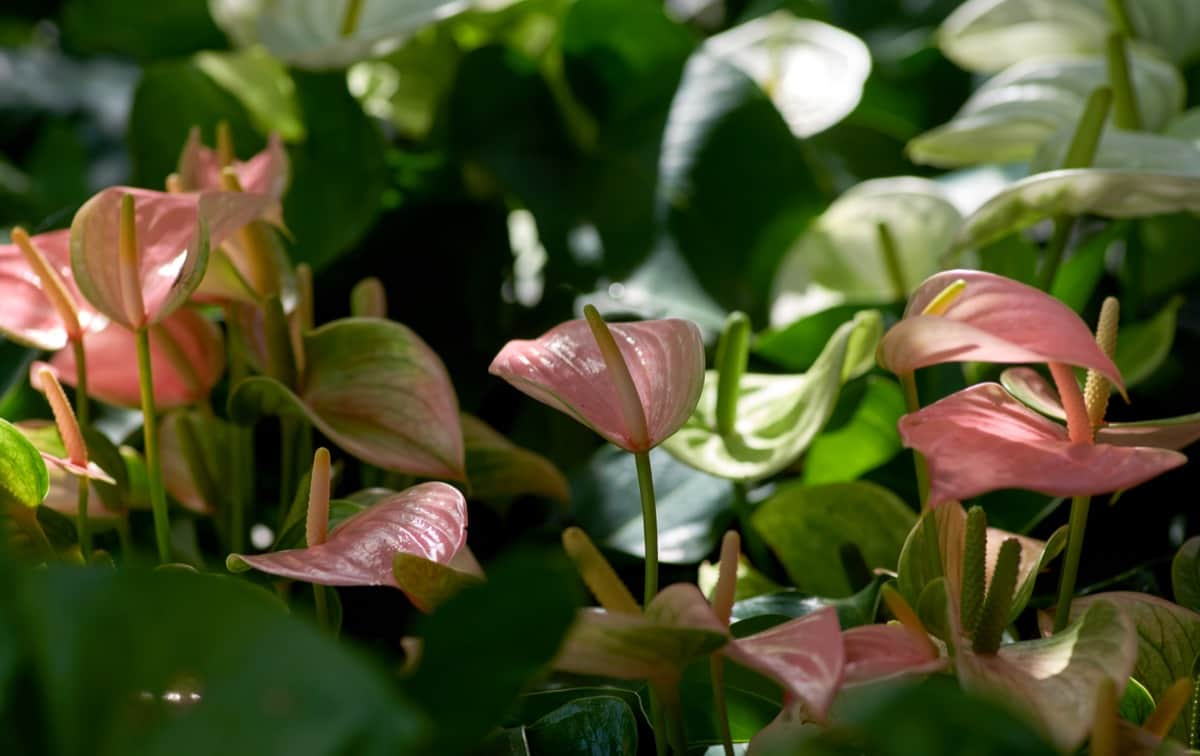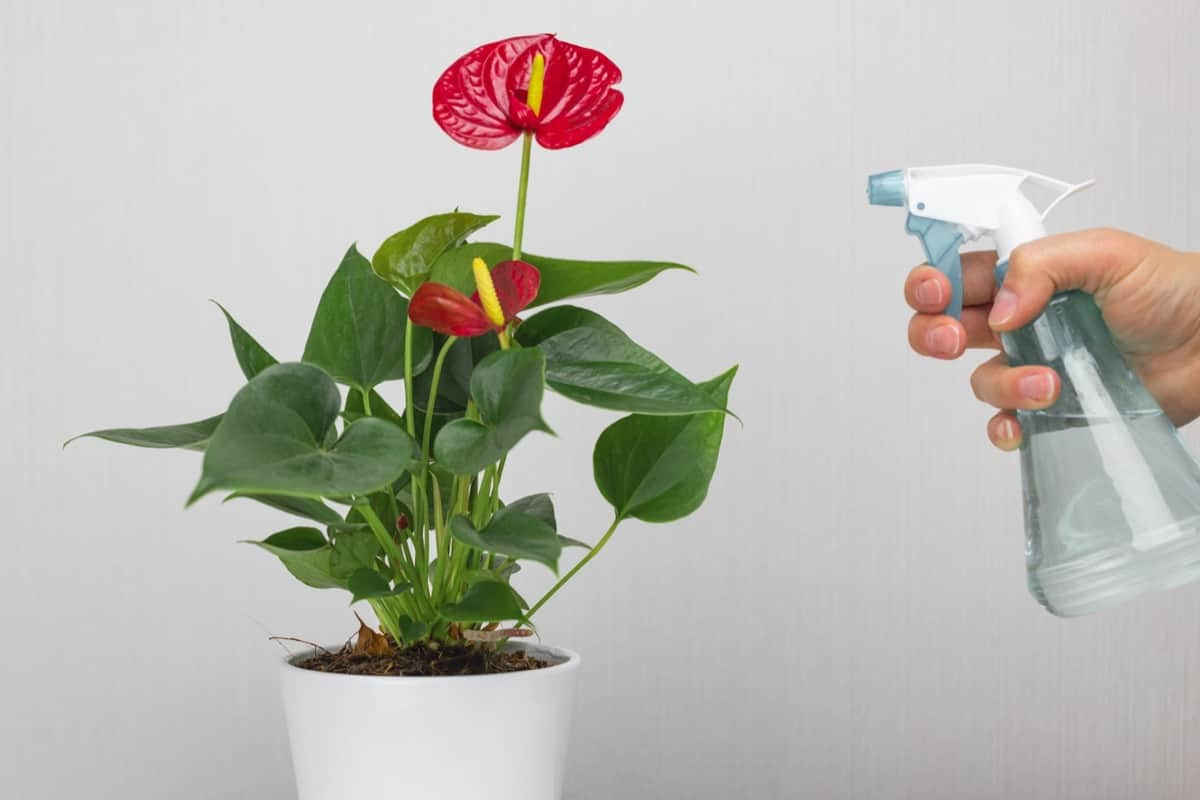Welcome to our blog on Common Anthurium plant pests and control! This article will explore the causal organisms, damage symptoms, spread, treatment options, prevention strategies, and management techniques for these pests. Join us and learn how to protect your anthurium plants and ensure a good yield. Let’s begin, then.

Common Anthurium Pests
Anthurium is a perennial flowering herb in the Araceae family, native to Central and South America. Anthurium is a beautiful tropical plant renowned for its strikingly vibrant and uniquely shaped flowers. They possess glossy, heart-shaped leaves with prominent veins, providing an attractive backdrop for their showy inflorescences. The flowers are composed of a brightly colored spathe, often red, pink, or white, which encloses the tiny true flowers called spadix, which aids in attracting pollinators.
| Pest | Characteristic Symptoms |
| Aphids | Feed on plant sap, honeydew, sooty mold, chlorosis, & distortion. |
| Thrips | Feed on upper leaf surfaces, scrape chlorophyll, & scarring. |
| Red Spider Mites | Webbings, bronzing, stippling, curling, and premature leaf drop. |
| Mealybugs | Cottony white structures, chlorosis, & reduced vigor. |
| Soft Brown Scale Insect | Scale-like bumps, chlorosis, wilting, distortion, & reduced vigor. |
| Anthurium Leaf Miner | Serpentine mines or tunnels and blister-like swellings. |
| Armyworms | Leaf skeletonization, silken threads, and stem dieback. |
| Broad Mites | Leaf curling & twisting, puckered appearance, & silvered leaves. |
| Eriophyid Mites | Silver or bronze discoloration of leaves, blistering, & puckering. |
| Anthurium Whitefly | Feed on plant sap, curling, reduced flowering, and vigor. |
Aphids Pest Control in Anthurium
- Causal Organism: Myzus circumflexus.
- Symptoms: They feed on the plant sap, excrete a sticky, sugary substance called honeydew, and promote the growth of black sooty mold. Infested plants show leaf curling, chlorosis, distortion, and reduced plant vigor.
- Favorable Conditions: They prefer mild to warm and moist conditions of 20-30 °C, succulent foliage, dense plantings, and stressed plants for feeding, reproduction, and survival.
- Treatment: Spray potassium salts of fatty acids, neem oil, imidacloprid, or acetamiprid. Practice pruning, sanitation, and companion planting with marigolds or chives. Use high-pressure water spray and yellow sticky traps to monitor and control aphids.
Thrips Pest Control in Anthurium
- Causal Organism: Chaetanaphothrips orchidii.
- Symptoms: Thrips feed on the upper leaf surfaces, scraping away chlorophyll and leaving behind a silvered or faded appearance. Infested plants show leaf deformation, frass droppings, and leaf and flower scarring.
- Favorable Conditions: They prefer mildly warm and humid weather of 25-30 °C, tender plant tissues, stressed plants, and crowded plantations.
- Treatment: Spray neem oil, bifenthrin, permethrin, imidacloprid, or acephate. Practice pruning, reflective barriers, jet spray, sanitation, and regular monitoring. Use predatory mites or minute pirate bugs.
Red Spider Mite Pest Control in Anthurium
- Causal Organism: Tetranychus cinnabarinus.
- Symptoms: The most noticeable symptom is their webbings that act as protective structures. Infested leaves show chlorosis, bronzing, distortion, stippling, curling, premature leaf drop, and reduced vigor.
- Favorable Conditions: They prefer warm and dry weather conditions of 27-32 °C and < 50% humidity, crowded plantations, poor airflow, and weeds.
- Treatment: Spray abamectin, pyrethroids, spiromesifen, etoxazole, and fenazaquin. Practice regular monitoring, pruning, and sanitation. Use high-pressure water spray, increase humidity, and predatory mites, ladybugs, or lacewings.
Mealybug Pest Control in Anthurium
- Causal Organism: Pseudococcus spp.
- Symptoms: Mealybugs are identified by their white, cottony, or waxy defense or moisture-retaining structures. Infested plants show leaf chlorosis, distortion, honeydew accumulation, sooty mold, and reduced plant vigor.
- Favorable Conditions: They prefer warm and humid environments of 24-32 °C and > 70% humidity, tender foliage, infested plant debris, and overcrowded plantations for reproduction.
- Treatment: Spray potassium salts of fatty acids, imidacloprid, or acetamiprid. Practice regular monitoring, pruning, sanitation, and manual removal using a soft brush dipped in rubbing alcohol or soapy water. Use jet spray, ladybugs, or lacewings.
In case you missed it: Common Orchid Diseases: Damage Symptoms, Spread, Treatment, and Prevention

Soft Brown Scale Insect Pest Control in Anthurium
- Causal Organism: Coccus hesperidum.
- Symptoms: Scale insects are identified by their defense, scale-like bumps attached to the foliage. Infested plants show leaf chlorosis, wilting, distortion, honeydew, sooty mold, stunted growth, and reduced vigor.
- Favorable Conditions: They prefer mildly warm and mildly humid weather of 26-31 °C and ~ 50% humidity, succulent foliage, poor airflow, crowded plantations, and stress conditions for reproduction and survival.
- Treatment and Management: Spray neem oil, potassium salts of fatty acids, imidacloprid, or acetamiprid. Practice sanitation, pruning, monitoring the plants regularly, using cotton dipped in rubbing alcohol or soapy water, and ladybugs or lacewings.
Anthurium Leaf Miner Pest Control in Anthurium
- Causal Organism: Philodoria spp.
- Symptoms: Anthurium leaf miners create yellowish-white serpentine mines or tunnels, and narrow trails follow contours on leaves. Infested leaves show blister-like swellings, reddish-brown appearance, distortion, reduced photosynthesis, and premature leaf drop.
- Favorable Conditions: They prefer warm and humid weather of 27-32 °C and > 80% humidity, smooth leaf structure, and infested plant debris for reproduction and survival.
- Treatment and Management: Spray imidacloprid, thiamethoxam, spinosad, or pyrethroids. Practice manually removing infested leaves, pruning, sanitation, and regular monitoring. Use parasitic wasps or predatory beetles.
Armyworms Pest Control in Anthurium
- Causal Organism: Mythimna unipuncta.
- Symptoms: Armyworms voraciously feed on the soft tissue between the veins, leaving behind a skeletonized, lacy, or transparent appearance. Infested plants show irregular holes, ragged edges or shredded appearance, defoliation, frass, silken threads, and stem dieback.
- Favorable Conditions: They prefer mildly warm and humid environments of 23-27 °C and ~ 60% humidity, dense vegetation, and migration aided by wind patterns.
- Treatment and Management: Spray Bt-based insecticides. Practice handpicking and dropping them into a bucket of soapy water, monitor the plants regularly, remove any visible egg masses or cocoons, and use parasitic wasps, predatory beetles, or birds.
Broad Mites Pest Control in Anthurium
- Causal Organism: Polyphagotarsonemus latus.
- Symptoms: The characteristic symptom is the curling and twisting of leaves. Infested plants show leaf distortion, wilting, curling, twisted or puckered appearance, bronzed or silvered leaves, rough texture, stunted growth, and malformed flowers.
- Favorable Conditions: They prefer warm and humid conditions of 27-35 °C and > 70% humidity, crowded plantations, infested plant debris, and poor airflow.
- Treatment and Management: Spray abamectin or spiromesifen. Practice isolation, pruning, and sanitation. Maintain proper ventilation, avoid overwatering, and reduce leaf wetness.
Eriophyid Mites Pest Control in Anthurium
- Causal Organism: Aceria spp.
- Symptoms: Eriophyid mites induce abnormal growth and deformities in the leaves. Infested leaves show silver or bronze discoloration, rough texture, curling, rolling, blistering, puckering, and flower wilting and distortion.
- Favorable Conditions: They prefer mildly warm and humid conditions of 21-25 °C and >80% humidity, poor airflow, infested plant debris, and overcrowding for reproduction.
- Treatment and Management: Spray pyrethroids, etoxazole, and spiromesifen. Practice pruning, isolation, sanitation, and maintaining adequate airflow.
Anthurium Whitefly Pest Control in Anthurium
- Causal Organism: Bemisia tabaci and Aleurotulus anthuricola.
- Symptoms: Whiteflies extract plant sap, inject toxic saliva, excrete honeydew, and promote sooty mold. Infested plants show leaf chlorosis, wilting, curling, distortion, reduced flowering, and vigor.
- Favorable Conditions: They prefer warm and moist weather of 28-36 °C, infested plant debris, dense plantings, and poor airflow for feeding and reproduction.
- Treatment and Management: Spray imidacloprid or acetamiprid. Practice pruning, sanitation, regular watering, and fertilization. Use yellow sticky traps to monitor the plants regularly. Release ladybugs, lacewings, or parasitic wasps.
In case you missed it: How to Identify and Treat Common Orchid Pests: Damage Symptoms, Spread, Control, and Prevention

Conclusion
Some major pests affecting anthurium plants include aphids, thrips, red spider mites, mealybugs, scale insects, leaf miners, armyworms, broad mites, eriophyid mites, and whitefly pests. Various organisms cause these pests and exhibit specific symptoms, modes of spread, and management approaches.
- Deworming Schedule for Dogs/Puppies: A Beginners Guide
- How to Prevent and Control Parasites in Goats
- Beneficial Insects in Pest Management
- Natural Solutions for Pest Control in Flower Gardens
- Types of Fungicides Used in Agriculture
- Common Issues in the Fruit Development Stage of Pomegranate Farming
- Fruit Development Issues in Papaya: Easy Solutions and Treatment
- Soil-Borne Diseases and How to Protect Your Plants
- Practices to Prevent Disease Spread in the Garden